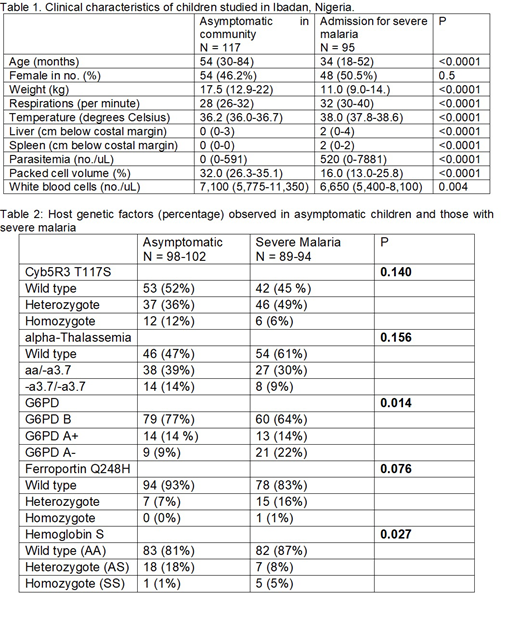Host genetic factors that influence the outcome of Plasmodium falciparum malaria infection are not fully understood. These include alpha-thalassemia, sickle cell disease, glucose-6-phosphate dehydrogenase (G6PD) deficiency and cytochrome b5 reductase 3 (CYB5R3) T117S and ferroportin Q248H polymorphisms. G6PD, an X-linked gene, encodes the sole enzyme in red blood cells that produces NADPH for protection from reactive oxygen species. Hemi- or homozygosity for G6PD A+ (G6PD c. 376G) is an African specific polymorphism with reduced activity (PMID:26633385) but no apparent phenotype; hemi- or homozygosity for G6PD A- (G6PD c 202A/376G) is associated with both decreased activity and increased risk for oxidant-induced hemolysis (PMID:27040960). A Malaria Genomic Epidemiology Network (MalariaGEN) study with almost 30,000 participants reported that G6PD A- increases the risk for severe malarial anemia (PMID:25261933). CYB5R3 in red blood cells transfers electrons from NADH to cytochrome b5, which in turn converts methemoglobin to hemoglobin. The African-specific CYB5R3 T117S variant, is not associated with methemoglobinemia (PMID:9048929) but may afford some protection from malarial anemia in Zambian children. A prevalent African-specific Q248H mutation of the iron exporter, ferroportin, may protect from high malarial parasitemia (PMID: 29599243).
We genotyped 212 Nigerian children (age 4 months - 16 years) for these genetic factors: 117 were asymptomatic children who were studied in the community and 95 were children who were studied at the time of admission to hospital with severe malaria (severe anemia and/or cerebral malaria). We isolated DNA from dried blood spots and crude DNA lysate was used for Taqman genotyping to screen for G6PD A+, G6PD A-, FPN Q248H, sickle cell disease and CYB5R3 T117S and multiplex PCR was used to identify the 3.7 kb and 4.2 kb α-globin gene deletions. The clinical characteristics of the two groups of children are shown in Table 1. Children with severe malaria were significantly younger than the children from the community.
The gene frequency of CYB5R3 T117S was 0.303, of hemoglobin S was 0.094, and of FPN Q248H was 0.062. The prevalences of hemizygous and homozygous G6PD A+ and A- were 13.9% and 16.0%, respectively. In addition, the prevalences of single and double alpha globin gene deletions were 34.7 % and 11.7%, respectively. Table 2 compares the prevalence of these genotypes in asymptomatic children versus those admitted with severe malaria. Alpha-thalassemia tended to be more prevalent in the asymptomatic children while ferroportin Q248H and G6PD A- were more prevalent in the children with severe malaria. Some genes seemed to have heterogenous associations: sickle trait and homozygous CYB5R3 T117S tended to be more prevalent in the asymptomatic children while hemoglobin SS and heterozygous T117S tended to be more prevalent in the children with severe malaria.
In a logistic regression model that adjusted for age, alpha thalassemia (odds ratio 0.6, P=0.038), hemoglobin S trait (odds ratio 0.5, P=0.203), and CYB5R3 T117S homozygous state (odds ratio 0.5, P=0.211) independently decreased the risk of severe malaria, while ferroportin Q248H (odds ratio 5.1, P=0.008) and G6PD deficiency (1.6, P=0.049) independently increased the risk of severe malaria.
In conclusion, our results suggest that common genetic factors affect the risk of severe malaria in children. Research to illuminate the mechanisms of these effects may enhance our understanding of the pathogenesis of severe malaria and point to novel preventive and therapeutic measures.
Gordeuk:Global Blood Therapeutics: Consultancy, Honoraria, Research Funding; Emmaus: Consultancy, Honoraria; Novartis: Consultancy, Honoraria, Research Funding; Modus Therapeutics: Consultancy, Honoraria; Pfizer: Research Funding; Inctye: Research Funding; CSL Behring: Consultancy, Honoraria, Research Funding; Ironwood: Research Funding; Imara: Research Funding.
Author notes
Asterisk with author names denotes non-ASH members.


This feature is available to Subscribers Only
Sign In or Create an Account Close Modal